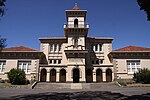Geelong ( jih-LONG) (Wathawurrung: Djilang/Djalang) is a port city in Victoria, Australia, located at the eastern end of Corio Bay (the smaller western portion of Port Phillip Bay) and the left bank of Barwon River, about 65 km (40 mi) southwest of Melbourne.
Geelong is the second largest Victorian city behind Melbourne with an estimated urban population of 268,277 as of June 2018, and is also Australia's second fastest-growing city. Geelong is also known as the "Gateway City" due to its critical location to surrounding western Victorian regional centres including Ballarat in the northwest, Torquay, Great Ocean Road and Warrnambool in the southwest, Hamilton, Colac and Winchelsea to the west, providing a transport corridor past the Central Highlands for these regions to the state capital Melbourne in its northeast. The City of Greater Geelong is also a member of the Gateway Cities Alliance in partnership with Councils from Newcastle and Wollongong.
Geelong is the administrative centre for the City of Greater Geelong municipality, which is Port Phillip's only regional metropolitan area, and covers all the urban, rural and coastal reserves around the city including the entire Bellarine Peninsula and running from the plains of Lara in the north to the rolling hills of Waurn Ponds to the south, with Corio Bay to the east and the Barrabool Hills to the west.
The traditional owners of the land on which Geelong sits were the Wadawurrung (also known as Wathaurong) Aboriginal people of the Kulin nation. The Wadawurrung Traditional Owners Aboriginal Corporation is the Registered Aboriginal Party for the region. The modern name of Geelong, established in 1827, was derived from the local Wadawurrung name for the region, Djilang, thought to mean "land", "cliffs" or "tongue of land or peninsula". The area was first surveyed by the European settlers in 1838, three weeks after Melbourne. A town post office was opened by June 1840, the second to open in the Port Phillip District.
The first woolstore was erected in this period and it became the port for the wool industry of the Western District.During the Victorian gold rush, Geelong experienced a brief boom as the main port to the rich goldfields of the Ballarat district. The town then diversified into manufacturing, and during the 1860s became one of the largest manufacturing centres in Australia with its wool mills, ropeworks, and paper mills. It was proclaimed a city in 1910, with industrial growth from this time until the 1960s establishing the city as a manufacturing centre for the state, and the population grew to over 100,000 by the mid-1960s. During the city's early years, an inhabitant of Geelong was often known as a Geelongite or a "Pivotonian", derived from the city's nickname of "The Pivot", referencing the city's role as a shipping and rail hub for the area. Population increases over the last decade were due to growth in service industries, as the manufacturing sector has declined. Redevelopment of the inner city has occurred since the 1990s, as well as gentrification of inner suburbs, and currently has a population growth rate higher than the national average.Today, Geelong stands as an emerging healthcare, education and advanced manufacturing centre. The city's economy is shifting quickly and despite experiencing the drawbacks of losing much of its heavy manufacturing, it is seeing much growth in other tertiary sectors, positioning itself as one of the leading non-capital Australian cities. It is home to the Geelong Football Club, the second oldest club in the Australian Football League.





